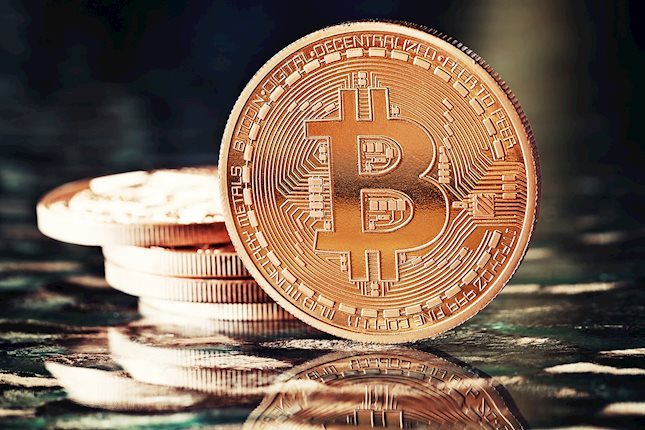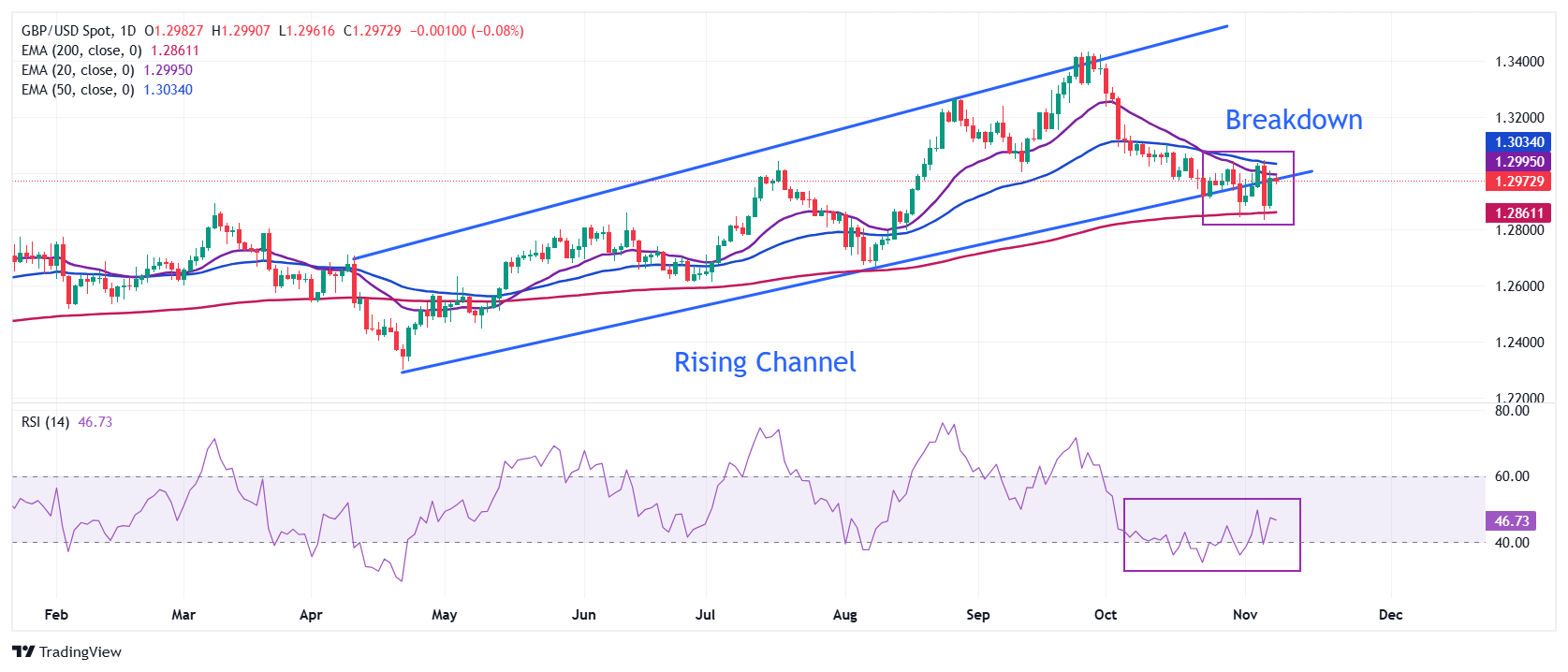- The Pound Sterling faces mild selling pressure on Friday even though the BoE favored a more gradual rate-cut path.
- Both the Fed and the BoE cut interest rates by 25 bps on Thursday.
- The Fed is expected to cut its key borrowing rates by 25 bps again in December.
The Pound Sterling (GBP) trades lower against the US Dollar (USD) below the psychological resistance of 1.3000 in Friday’s North American session. The GBP/USD weakens slightly as the US Dollar rebounds after a sharp correction on Thursday. The US Dollar Index (DXY), which gauges Greenback’s value against six major currencies, trades in a tight range near 104.50.
The Greenback retraced almost 60% of Wednesday’s rally on Thursday as traders unwinded some of the so-called ‘Trump trades’ and the Federal Reserve (Fed) Chair Jerome Powell’s commentary was interpreted as slightly dovish. The US Dollar rallied in October and in the first week of November as traders priced in Republican Donald Trump’s victory in the United States (US) presidential election.
The Federal Reserve cut interest rates by 25 basis points (bps) to 4.50%-4.75%, as expected. Jerome Powell said in the press conference following the decision that he remained confident over the continuation of the policy-easing cycle, adding that the disinflation trend towards the bank’s target of 2% is intact and that there are some signs of slowing labor market conditions.
On Trump’s victory, Powell said he sees no near-term effects on the interest rate path and refrained from speculating about it. Trump’s victory is widely seen as inflationary, given that he promised to raise import tariffs and lower corporate taxes in his election campaign.
According to the CME FedWatch tool, the likelihood of an interest rate cut of 25 bps to 4.25%-4.50% in the December meeting is 71.3%.
In Friday’s session, investors will focus on Fed Governor Michelle Bowman’s speech for fresh interest rate guidance, which is scheduled at 16:00 GMT. Still, it is uncertain if Bowman will talk about monetary policy as she participates in a symposium about banking.
Daily digest market movers: Pound Sterling trades with caution as UK employment comes under focus
- The Pound Sterling trades cautiously against the majority of its pairs on Friday even though the commentary from Bank of England (BoE) Governor Andrew Bailey on interest rates on Thursday was less dovish than what market participants had anticipated.
- After the bank reduced its key borrowing rates by 25 bps to 4.75%, Bailey commented that interest rates will continue to fall gradually if the economy evolves as expected. However, he emphasized that the monetary policy will remain restrictive until the risks of inflationary pressures remaining persistent get dissipated.
- When asked about the impact of last week’s Autumn Forecast Statement on the interest rate path, Bailey said: "I don't think that it's sensible to conclude that the path of interest rates will be particularly different." However, Bailey also said that fiscal measures would boost the overall growth by around three-quarters of a percent at their peak in a year's time, pointing to stronger and relatively front-loaded paths for government consumption and investment, more than offsetting the impact on growth of higher taxes.
- Bailey refrained from making any presumption about the impact of US Donald Trump's administration on the UK economy but said that the central bank will remain vigilant to Trump's trade policy decisions.
- Going forward, investors will focus on the United Kingdom (UK) employment data for the three months ending September, which will be published on Tuesday.
British Pound PRICE Today
The table below shows the percentage change of British Pound (GBP) against listed major currencies today. British Pound was the strongest against the Australian Dollar.
| USD | EUR | GBP | JPY | CAD | AUD | NZD | CHF | |
|---|---|---|---|---|---|---|---|---|
| USD | 0.39% | 0.32% | -0.11% | 0.35% | 1.01% | 0.73% | 0.19% | |
| EUR | -0.39% | -0.08% | -0.46% | -0.05% | 0.61% | 0.33% | -0.19% | |
| GBP | -0.32% | 0.08% | -0.40% | 0.03% | 0.69% | 0.40% | -0.13% | |
| JPY | 0.11% | 0.46% | 0.40% | 0.44% | 1.10% | 0.81% | 0.28% | |
| CAD | -0.35% | 0.05% | -0.03% | -0.44% | 0.64% | 0.37% | -0.16% | |
| AUD | -1.01% | -0.61% | -0.69% | -1.10% | -0.64% | -0.28% | -0.82% | |
| NZD | -0.73% | -0.33% | -0.40% | -0.81% | -0.37% | 0.28% | -0.53% | |
| CHF | -0.19% | 0.19% | 0.13% | -0.28% | 0.16% | 0.82% | 0.53% |
The heat map shows percentage changes of major currencies against each other. The base currency is picked from the left column, while the quote currency is picked from the top row. For example, if you pick the British Pound from the left column and move along the horizontal line to the US Dollar, the percentage change displayed in the box will represent GBP (base)/USD (quote).
Technical Analysis: Pound Sterling stays afloat above 200-day EMA
The Pound Sterling trades at make or a break against the US Dollar near the breakdown region of a Rising Channel pattern, just below 1.3000 on Friday, after rebounding from a fresh 11-week low near 1.2830 on Wednesday. The GBP/USD pair remains well-supported by the 200-day Exponential Moving Average (EMA) around 1.2860.
However, the near-term trend is bearish as the 20-day and 50-day EMAs, around 1.3000 and 1.3035, respectively, are declining.
The 14-day Relative Strength Index (RSI) hovers near 40.00. A bearish momentum would resume if the RSI (14) fails to hold this level.
Looking down, the round-level support of 1.2800 will be a major cushion for Pound Sterling bulls. On the upside, the Cable will face resistance near the psychological figure of 1.3000.
Information on these pages contains forward-looking statements that involve risks and uncertainties. Markets and instruments profiled on this page are for informational purposes only and should not in any way come across as a recommendation to buy or sell in these assets. You should do your own thorough research before making any investment decisions. FXStreet does not in any way guarantee that this information is free from mistakes, errors, or material misstatements. It also does not guarantee that this information is of a timely nature. Investing in Open Markets involves a great deal of risk, including the loss of all or a portion of your investment, as well as emotional distress. All risks, losses and costs associated with investing, including total loss of principal, are your responsibility. The views and opinions expressed in this article are those of the authors and do not necessarily reflect the official policy or position of FXStreet nor its advertisers. The author will not be held responsible for information that is found at the end of links posted on this page.
If not otherwise explicitly mentioned in the body of the article, at the time of writing, the author has no position in any stock mentioned in this article and no business relationship with any company mentioned. The author has not received compensation for writing this article, other than from FXStreet.
FXStreet and the author do not provide personalized recommendations. The author makes no representations as to the accuracy, completeness, or suitability of this information. FXStreet and the author will not be liable for any errors, omissions or any losses, injuries or damages arising from this information and its display or use. Errors and omissions excepted.
The author and FXStreet are not registered investment advisors and nothing in this article is intended to be investment advice.
Recommended content
Editors’ Picks

EUR/USD tumbles to 2024 lows near 1.0460
The US Dollar gathers extra pace and weigh on the risk complex, sending EUR/USD to new YTD lows near the 1.0460 region as the NA draws to a close on Thursday.

GBP/USD dips to multi-month lows around 1.2570
Further losses now motivate GBP/USD to revisit the vicinty of the 1.2570 zone for the first time since early May, always on the back of the strong move higher in the Greenback.

Gold faces extra upside near term
Gold extends its bullish momentum further above $2,660 on Thursday. XAU/USD rises for the fourth straight day, sponsored by geopolitical risks stemming from the worsening Russia-Ukraine war. Markets await comments from Fed policymakers.

BTC hits an all-time high above $97,850, inches away from the $100K mark
Bitcoin hit a new all-time high of $97,852 on Thursday, and the technical outlook suggests a possible continuation of the rally to $100,000. BTC futures have surged past the $100,000 price mark on Deribit, and Lookonchain data shows whales are accumulating.

A new horizon: The economic outlook in a new leadership and policy era
The economic aftershocks of the COVID pandemic, which have dominated the economic landscape over the past few years, are steadily dissipating. These pandemic-induced economic effects are set to be largely supplanted by economic policy changes that are on the horizon in the United States.

Best Forex Brokers with Low Spreads
VERIFIED Low spreads are crucial for reducing trading costs. Explore top Forex brokers offering competitive spreads and high leverage. Compare options for EUR/USD, GBP/USD, USD/JPY, and Gold.
